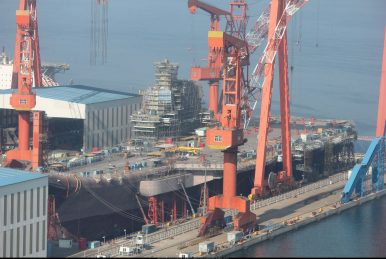By Franz-Stefan Gady
 The People’s Liberation Army Navy’s (PLAN) next-generation aircraft carrier, designated Type 002, will likely be fitted with an advanced electromagnetic catapult system for launching aircraft, according to Chinese military experts. Chinese engineers have allegedly successfully developed a new integrated propulsion system (IPS)–“a medium-voltage, direct-current transmission network”—which would allow more power for a catapult assisted take-off but arrested recovery (CATOBAR) aircraft launch system similar to the U.S. Navy’s electromagnetic aircraft launch system (EMALS) without having to resort to nuclear power, the South China Morning Post (SCMP)reported on November 1.
The People’s Liberation Army Navy’s (PLAN) next-generation aircraft carrier, designated Type 002, will likely be fitted with an advanced electromagnetic catapult system for launching aircraft, according to Chinese military experts. Chinese engineers have allegedly successfully developed a new integrated propulsion system (IPS)–“a medium-voltage, direct-current transmission network”—which would allow more power for a catapult assisted take-off but arrested recovery (CATOBAR) aircraft launch system similar to the U.S. Navy’s electromagnetic aircraft launch system (EMALS) without having to resort to nuclear power, the South China Morning Post (SCMP)reported on November 1.
A PLAN aircraft carrier equipped with EMALS would substantially boost the PLANs carrier force’s combat power. “CATOBAR aircraft launch systems put less strain on the airframe of planes during takeoff reducing maintenance cost in the long run and also allows carrier-based aircraft to carry a heavier weapons payload,” I explained elsewhere. “Furthermore, CATOBAR launch systems increase the sortie rates of carrier air wings by allowing a faster landing and takeoff rate.”Enjoying this article? Click here to subscribe for full access. Just $5 a month.
Among other things, it would allow the PLAN to launch including aerial tankers, airborne early warning aircraft, anti-submarine warfare (ASW) planes, and transport aircraft from the carrier’s deck.
The Type 002 could become the first non-Western carrier to be equipped with a CATOBAR aircraft launch system. (The Indian Navy’s new aircraft carrier, the 65,000-ton supercarrier INS Vishal, will also likely feature CATOBAR technology. However, the carrier construction program has been hampered by delays and it is likely that the Type 002 will be commissioned before the INS Vishal.) The PLAN has reportedly been evaluating CATOBAR systems, one steam and the other electromagnetic, at the Xincheng Aircraft Training Center.
The PLA has run “hundreds of tests” using the EMALS with Shenyang J-15 multirole fighter jets, a variant of the fourth-generation Sukhoi Su-33 twin-engines air superiority fighter, Yin Zhuo, a senior researcher at the PLA Naval Equipment Research Center, said in an interview with China Central Television on November 3.
According to PLA naval expert, senior Chinese military is keen to use the new IPS for the carrier. “China doesn’t need to copy the United States and use nuclear reactors to support EMALS and other energy-hungry weapons on the ship, because it now has more advanced technologies to solve the problem,” the expert claims.
“China now has mature technologies … [and] the PLA is narrowing the gap with the U.S.,” he added. The PLAN’s top naval engineer Rear Admiral Ma Weiming, claims that the Chinese EMALS variant will be superior to U.S. technology. The U.S. Navy’s next-generation of aircraft carriers, the nuclear-powered Gerald R. Ford-class, is slated to be equipped with EMALS, despite objections to its installation by U.S. President Donald Trump.
The new IPS would reportedly allow the Type 002 to be armed with high-energy consuming laser weapon systems and electromagnetic guns. The new carrier will purportedly have a displacement of around 85,000 tons. Construction of the carrier allegedly started already in February 2016. However, senior Chinese military officials have acknowledged multiple delays in the carrier program and there have been some indications that the program has been halted.
No comments:
Post a Comment